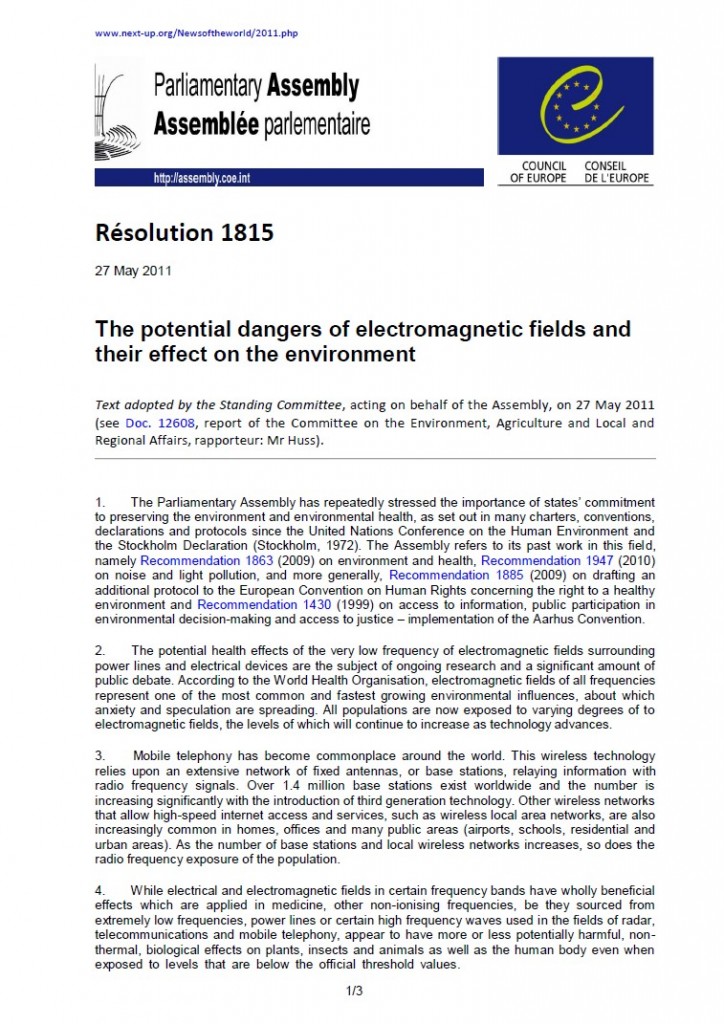Portada del sitio > Estudios Científicos > EEUU: Secretos del Instituto de Salud Ambiental/ Institute of Environmental (...)

EEUU: Secretos del Instituto de Salud Ambiental/ Institute of Environmental Health Secrets:
Domingo 13 de diciembre de 2015 · 963 lecturas
Institute of Environmental Health Secrets:
NIEHS Mum on $25 Million RF Animal Project
From Microwave News
Microwaves News, revista estadounidense editada por el Doctor Louis Slesin en la que se publican desde hace más de treinta años artículos relativos a los efectos de las radiofrecuencias en la salud, acaba de publicar un nuevo artículo en el que se evidencia el secretismo con el que el Instituto Nacional de Ciencias de la Salud Medioambiental de Estados Unidos (dependiente del Departamento de Salud de los Estados Unidos) está tratando la investigación que se ha llevado a cabo desde 1999 en el Proyecto de Radiofrecuencias del “Programa Nacional de Toxicología”, coordinado por el profesor Doctor Michael Wyde (proyecto en el que se han invertido más de 25 millones de dólares).
Se trata de un proyecto para asesorar sobre el riesgo de cáncer por radiofrecuencias emitidas sobre animales en laboratorio. Ha sido el proyecto más caro del Programa Nacional de Toxicología. La presentación de Michael Wyde del año 2013, cuyo power point adjunta la revista Microwaves News, fue obtenida tras diversas dificultades.
Los experimentos piloto encontraron que las ratas respondieron a la radiación provocada por teléfonos celulares. Los animales expuestos antes y después de nacer aumentaron de peso más lentamente que los no expuestos. Estos resultados se han presentado únicamente en círculos muy restringidos, pero no ante el gran público ni la prensa.
Solicitada una entrevista por Microwaves News a Michael Wyde, éste no respondió a la invitación. Tampoco ha respondido a los mensajes que se le han enviado en los últimos años desde la revista. El 5 de enero de 2015, Microwaves News solicitó los documentos relacionados con el Proyecto de Radiofrecuencias (copia de los informes de avance mensuales) al amparo de la Ley de Libertad de la Información (según esta Ley las Agencias Federales deben responder a estos requerimientos en un plazo de veinte días), sin que dicho requerimiento haya tenido ningún efecto.
Tras diversas peticiones de documentación, Patricia Stockton, del Instituto Nacional de Ciencias de la Salud Medioambiental, y Bruce Androphy, abogado director de la Oficina de Ética del mismo Instituto, han venido dando largas o no han respondido a las peticiones de Microwaves News.
Skirts Freedom of Information Act
Share on facebookShare on emailShare on twitterShare on print
November 30, 2015
Last updated
December 1, 2015
NIEHS really doesn’t want to talk about it. Ten years into a $25+ million project to assess the cancer risk of wireless radiation in laboratory animals, the staff at the National Institute of Environmental Health Sciences remains tight-lipped and refuses to release project documents.
NIEHS has many reasons for keeping a low profile. The RF project, the most expensive in National Toxicology Program history, is years late and two-to-three times over budget. A more immediate concern is that it could force the institute into a position it would desperately prefer to avoid: Being at the center of the ever-contentious controversy over cell phone radiation and cancer.
NIEHS could end up being in the hot seat at a time industry lobbyists and some radiation officials are trying to downplay RF’s IARC designation as a possible human carcinogen. But if the ongoing animal studies were to show a cancer risk, there would be intense pressure to move in the opposite direction: An upgrade from possible to probable (and perhaps to known). It would not be a hard sell after Alex Lerchl’s group in Germany reported that RF promoted cancer in mice earlier this year.
There’s another reason: Pilot NTP experiments found that rats did respond to both GSM and CDMA cell phone radiation. Those exposed before and after birth gained weight more slowly. The exposure levels were higher than those normally associated with cell phones and Wi-Fi, but close enough to challenge the widely-held view that wireless radiation is harmless. Importantly, the observed effects were dose-dependent.
These results have been circulating among a select few, while NIEHS has been keeping them out of public view. NIEHS’ Michael Wyde, the coordinator of the NTP project, disclosed them at a by-invitation-only meeting more than two years ago. (We’ve been told that they made an impression on those who were there; we should also note that these findings are not directly related to cancer.)
Wyde ppt at GLORE 2013
The first slide of Michael Wyde’s PowerPoint from his talk at the November 2013 GLORE meeting in Washington DC
Wyde was speaking at the annual meeting of the Global Coordination of Research and Health on RF Electromagnetic Fields (known as GLORE), held that year, 2013, at the FCC offices in Washington. Microwave News has obtained a copy of Wyde’s GLORE PowerPoint; download it here. The public and the press were barred from the meeting, while representatives from Motorola and Orange (formerly France Telecom) were allowed to attend (see the program here).
In his talk, Wyde also presented an overview of the RF chronic experiments which include exposing rats and mice for two years (but, to the dismay of some, not for the animals’ entire lifetime) to either GSM or CDMA cell phone-like signals at SARs ranging from 1.5 W/Kg to 10 W/Kg. Wyde did not respond to a request for an interview.
NIEHS Refuses To Release RF Documents
Over the years, Wyde has not answered any of our messages asking for project updates. So, on January 5, 2015, Microwave News filed a request under the Freedom of Information Act (FOIA) for documents related to the NTP RF Project. We specifically asked for copies of monthly progress reports, required under the contract between NIEHS and IITRI in Chicago, where the exposures were carried out under the leadership of David McCormick. The contract took effect on August 18, 2005. Eleven months after we made our request, NIEHS has not released any of the more than 120 monthly reports, which should have been submitted by IITRI.
Under the FOIA law, federal agencies are charged with responding to requests for documents within 20 working days, just about a calendar month.
Microwave News also requested copies of Wyde’s presentations as well as any by his boss, John Bucher, the associate director and operational head of the NTP. On March 16, Patricia Stockton, the NIEHS’ freedom of information coordinator, made available a number of Wyde’s PowerPoints, but without specifying when and where they had been presented. When we asked for clarification, Stockton replied that NTP staff had informed her that the “dates may be embedded within the presentations.” We could not find them, perhaps because we did not know where to look. She maintained that, “We do not have any other dates associated with these presentations.”
Wyde’s presentation at GLORE 2013, which had been shared with Motorola and Orange more than a year earlier, was not among the undated PowerPoints we received from Stockton in response to our FOIA request.
We followed up and asked Stockton for a firmer timeline on the release of the monthly reports. She responded that members of the NIEHS team had located about 90 documents and the search was continuing. “They have more to gather,” Stockton wrote. More than eight months later, none of those documents has yet been released.
On April 20, frustrated by NIEHS’ stonewalling and thinking that this was perhaps not only a violation of law but a breach of ethics, we wrote to Bruce Androphy, an attorney who serves as the director of the NIEHS Ethics Office. (Yes, there is an ethics office.) In a terse reply, Androphy made it clear he saw no need to get involved. He just stated that our FOIA request “is still being processed.” That is where the request stands today, more than six months later. By not denying it, NIEHS is able to block an appeal to a higher and, presumably, a more disinterested party —a strategy increasingly being used by government agencies to thwart compliance with the FOIA law.
More recently, we wrote to Bucher to ask why the institute is keeping the public dark about the project. We also asked what was causing all the delays. Back in 2009, Bucher had told a U.S. Senate hearing that the results of the NTP experiments would be ready for review in 2014. Bucher did not respond.
In 2010, long before the NTP experiments got underway, Bucher stunned some observers by predicting that the $25 million project would come up empty, telling a reporter that they would not see any indications that RF radiation is a cancer agent. (See “Will NIEHS Ever ‘Get’ EMFs.”)
Federal Health Agencies Left in the Dark
Meanwhile, the federal agencies charged with addressing RF health risks are waiting for the results. The NTP project came up at last month’s teleconference of the Interagency RF Working Group. Everyone had lost track of it. “No one has been talking about it,” Jerry Puskin, the director for science and technology in EPA’s Radiation Protection Division and a member of the working group, said in an interview. “The results could be very important.”
Joe Bowman at NIOSH in Cincinnati, another working group member, put the NTP project in context: “With this big animal study out there, what I tell workers about their RF exposures today could be wrong tomorrow. I think the debate on RF and cancer is on a knife’s edge. It could go either way.”
Robin Mackar, the news director at NIEHS, offered the following status report by e-mail:
“There are several manuscripts in preparation that will describe the design and function of the reverberation chamber exposure system, and results from the pilot studies on the effects on mice and rats of short-term exposures to RFR including body temperature, body weight, and survival and assessments of damage to DNA. We anticipate submission to peer-reviewed journals very soon. The major in-life portion of the studies is complete and the animals are currently in pathology.”
We wrote back to Mackar to ask if there really was no one at NIEHS who would be willing to talk about the project. She did not reply.
NTP RF Animal Project: Timeline
1999 FDA nominates RF from wireless devices for testing by NTP
2001 NTP decides to sponsor RF–cancer studies (cost $10 million)
2003 NTP solicits proposals for RF–cancer experiments
2004 NTP issues second request for proposals
2005 NTP signs contract with IITRI in Chicago to carry out exposures
2007 Exposure systems made by IT’IS installed at IITRI
2009 Principal investigator Ron Melnick retires, Michael Wyde takes over
2013 Wyde presents results of pilot studies at GLORE meeting
2014-15 Exposures of two-year studies completed
2016 Final results anticipated.
Ver la información original AQUÍ







